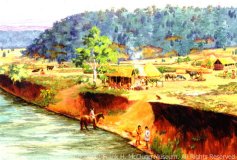 |
| NHC Home |
|
The Effects of Removal on American Indian Tribes Clara Sue Kidwell, University of North Carolina at Chapel Hill ©National Humanities Center |
|
(part 1 of 7)
Brummett Echohawk (Pawnee artist), "Trail of Tears," 1957
enlarge imageThe removal of American Indian tribes from lands east of the Mississippi River to what is now the state of Oklahoma is one of the tragic episodes in American history. Early treaties signed by American agents and representatives of Indian tribes guaranteed peace and the integrity of Indian territories, primarily to assure that the lucrative fur trade would continue without interruption. American settlers' hunger for Indian land, however, led to violent conflict in many cases, and succeeding treaties generally compelled tribes to cede large areas to the United States government.
Norma Howard (Choctaw artist), "Choctaw Village," ca. 1998
enlarge imageOne rationale for these treaties was that Indians were migratory hunters who only followed the game and had no attachment to any particular lands. This rationale ignored the fact that tribes in the southeast raised significant crops of corn and lived in settled villages. Americans were already swayed by arguments based on stereotypes of Indians as hostile, savage, wandering people. For students, the question is to what extent these stereotypes still persist in their thinking.
Orders for removal of Cherokee from North Carolina, Georgia, Tennessee and Alabama, 1838
full textOrders for removal of Cherokee from Georgia, 1838
full textNotice to the Cherokee that steam boats will be available for their transportation to territory west of the Mississippi, 1838
full textThe final removal came under the Indian Removal Act. Missionary societies who had invested their time and money teaching Indians to live with their white neighbors and accept Christianity lobbied Congress to oppose the act. It finally passed, but only by a one-vote margin, in September of 1830. The Choctaw, Cherokee, Chickasaw, Creeks, and Seminoles signed treaties agreeing to leave their homes in the southeast and move west. Their travels were marked by outbreaks of cholera, inadequate supplies, bitter cold, and death from starvation and exhaustion. The Cherokees' march was a forced one under the direction of the United States army, and it came to be known as the "Trail of Tears" or, in their own term, "The Place Where They Cried." Removal was a tragedy as thousands of people were forced to leave behind their homes, livestock, crops, and places that had spiritual significance for them.
Depiction of Cherokee farmstead of the mid 1700s, based on historic descriptions and archaeological excavations from the Lower Little Tennessee River Valley, eastern Tennessee, 1967-1982
enlarge imageArchaeological evidence, native oral traditions, and written sources help us reconstruct the past and understand the way in which landscape shaped the culture and the history of these people in their original homelands and how they had to adapt to a new environment west of the Mississippi River.
| "Native Americans and the Land" Essays |
| Pleistocene Die-Off |
The Columbian Exchange | Indian Removal | Buffalo Tales Essay-Related Links |
TeacherServe Home Page
National Humanities Center
7 Alexander Drive, P.O. Box 12256
Research Triangle Park, North Carolina 27709
Phone: (919) 549-0661 Fax: (919) 990-8535
Revised: September 2010
nationalhumanitiescenter.org





